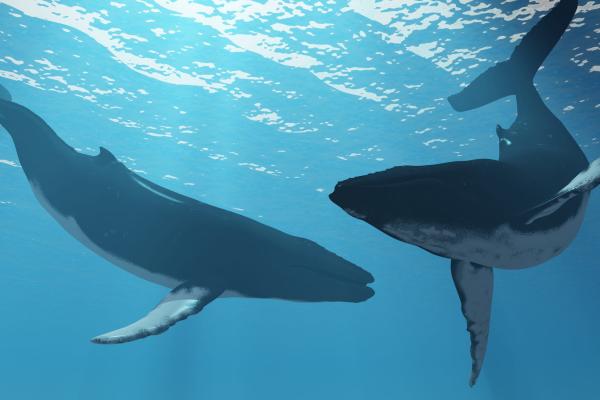
BOEM’s Use of Passive Acoustic Monitoring (PAM) Technology
PAM is a useful tool for:
- Observing the presence of vocalizing species
- Measuring the received levels of anthropogenic sound sources
- Quantifying the levels and patterns of naturally occurring sounds, including those from marine life
Across BOEM’s programs, PAM may be employed for several purposes:
- Short-term recordings measure sound levels from pile-driving operations and active acoustic sources.
- During seismic surveys and construction, real-time PAM is used to alert operators when vocalizing species are nearby.
- For several years pre- and post-construction of offshore wind farms, archival PAM systems will record the presence of vocalizing marine mammals and fish.
BOEM has worked with several stakeholders to establish a long-term regional PAM Network in the Atlantic Ocean to centralize acoustic data and share them alongside other data streams. This network will allow for a more robust analysis and greater understanding of where animals are and, ideally, insights about what they are doing. The effort will initially focus on whether there a measurable change in baleen whale distributions due to offshore wind development or another stressor, but additional species may also be recorded and analyzed. Working with staff in BOEM’s Office of Renewable Energy Programs, the CMA hosted several workshops to gather input from key stakeholders on this PAM network. The workshop reports can be found at the links below.
Given the many changes that are already occurring in the northwest Atlantic Ocean, scientists will need to collect other oceanographic data - alongside PAM data - to determine the cause of any detected change. BOEM plans to collate oceanographic data collected by many entities along the east coast (including offshore wind lessees), and eventually incorporate these data, along with PAM data, into a larger multivariate analysis.
BOEM has used PAM for decades and has funded several studies that have utilized PAM to answer important questions about the marine environment and life within it. Links to some of these studies are below. Working with BOEM’s Environmental Studies Program, the CMA has developed the BOEM Acoustics Science Strategy (BASS) to ensure current and future informational needs are addressed by taking a proactive approach to addressing knowledge gaps.
Finding of No Historic Properties Affected for Passive Acoustic Monitoring on the Atlantic OCS
In preparation for deploying PAM units throughout the Atlantic OCS, BOEM has made a Finding of no historic properties affected. The final findings document can be found at: Final Finding of No Historic Properties Affected for Passive Acoustic Monitoring Activities on the Atlantic Outer Continental Shelf. BOEM received no substantive comments on our draft findings document.
Establishing a PAM network entails acquiring and deploying passive acoustic equipment and then analyzing the acoustic data to assess anthropogenic noise and species presence. BOEM has identified potential areas where units may be deployed and will utilize existing survey data to avoid any archaeological resources. For areas that have not been previously surveyed, BOEM will avoid affecting any potential historic properties by imposing specific requirements of the deployment teams, including targeted pre-deployment surveys using de minimis sources like echosounders.
PAM-Related Studies and Reports
- Power Analysis for Optimal Design of a Passive Acoustic Monitoring Network for US East Coast Offshore Wind (July 2023)
- Northern GOM Passive Acoustic Monitoring Program Report (November 2022)
- Characteristics and Contributions of Noise Generated by Mechanical Cutting During Conductor Removal Operations, Volume 1: Final Report. Characteristics and Contributions of Noise Generated by Mechanical Cutting During Conductor Removal Operations; Volume 2: Appendix A, & Characteristics and Contributions of Noise Generated by Mechanical Cutting During Conductor Removal Operations, Volume 3: Appendices B-F (June 2022)
- Improving Monitoring, Data Consistency, Archiving, and Access for Improved Regional Integration of Renewable Energy Science: Workshop Summary on Passive Acoustic Monitoring Data Standards and Management (March 7 and 9, 2022)
- Improving Monitoring, Data Consistency, Archiving, and Access for Improved Regional Integration of Renewable Energy Science: Workshop Summary on Passive Acoustic Monitoring and Marine Mammals (June 2-3, 2021)
- NOAA and BOEM Minimum Recommendations for Use of Passive Acoustic Listening Systems in Offshore Wind Energy Development Monitoring and Mitigation Programs (October 2021)
- Optimization of Towed Passive Acoustic Monitoring (PAM) Array Design and Performance Study (Passive Acoustic Monitoring Study) (February 2021)
- Determining Habitat Use by Marine Mammals and Ambient Noise Levels Using Passive Acoustic Monitoring Offshore of Maryland (November 2018)

